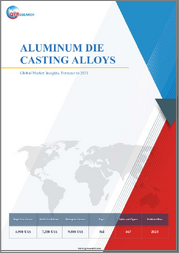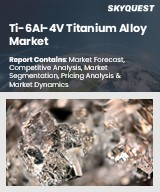
|
시장보고서
상품코드
1503376
수소 저장 합금 시장 예측(-2030년) : 유형별, 저장 용량별, 판매채널별, 기술별, 용도별, 지역별 세계 분석Hydrogen Storage Alloys Market Forecasts to 2030 - Global Analysis By Type (Metal Hydrides, Complex Hydrides, Intermetallic Compounds, Chemical Hydrides and Other Types), Storage Capacity, Sales Channel, Technology, Application and By Geography |
||||||
Stratistics MRC에 따르면 세계의 수소 저장 합금 시장은 2024년에 35억 4,000만 달러를 차지하고 예측 기간 중 CAGR은 7.8%로, 2030년에는 52억 1,000만 달러에 달할 전망입니다.
수소 저장 합금은 가역적인 화학 반응을 통해 수소 가스를 흡수하고 방출할 수 있는 물질입니다. 이러한 합금은 주로 니켈, 티타늄, 희토류 원소 등의 금속으로 구성되며, 수소를 흡수하면 금속수소화물을 형성합니다. 주요 용도는 수소 저장 시스템으로, 연료전지 및 에너지 저장을 포함한 다양한 용도의 수소를 안전하고 효율적으로 저장할 수 있는 수단을 제공합니다. 이 합금은 높은 저장 용량, 안정성, 특정 조건에서 제어 가능한 속도로 수소를 방출하는 능력으로 평가받고 있습니다.
국제에너지기구(IEA)에 따르면 전기분해 메커니즘을 통해 생산되는 수소는 미래에 큰 잠재력을 가지고 있으며, 저렴한 연료로 큰 기대를 모으고 있습니다.
청정 에너지에 대한 수요 증가
수소 저장 합금은 청정 에너지 운반체인 수소를 저장하고 연료전지 및 기타 용도에 활용하는 데 중요한 역할을 합니다. 산업계와 정부가 이산화탄소 배출량을 줄이기 위해 재생 에너지로 전환함에 따라 수소 저장 기술에 대한 수요가 증가하고 있습니다. 이는 수소 저장 합금의 발전과 투자를 촉진하여 효율성, 용량 및 비용 효율성을 향상시키고 시장 성장을 가속할 것입니다.
인프라의 한계
수소 충전소 부족과 같은 인프라 제약은 수소 저장 합금 시장에 큰 도전이 되고 있습니다. 제한된 인프라는 수소연료전지차의 보급을 방해하고 수소저장 합금 수요를 제한하고 있습니다. 또한 수소 충전 인프라 구축과 관련된 높은 비용이 투자 및 보급을 저해하고 시장 성장을 둔화시키고 있습니다.
자동차 분야에서의 채택 증가
수소 합금은 자동차 운행에 필수적인 연료전지에서 수소를 효율적으로 저장하고 방출하는 데 필수적입니다. 친환경 운송 솔루션에 대한 수요가 증가함에 따라 자동차 제조업체들은 수소 연료전지 기술에 대한 투자를 늘리고 있습니다. 이에 따라 첨단 수소 저장 솔루션에 대한 필요성이 높아지면서 수소 저장 합금 시장이 활성화되고 있습니다. 이산화탄소 배출량 감소에 대한 관심이 높아지면서 이러한 성장 추세가 더욱 가속화되고 있습니다.
대안 기술과의 경쟁
압축수소 가스 및 탄소 기반 소재와 같은 대체 기술과의 경쟁은 수소 저장 합금 시장에 도전하고 있습니다. 압축 수소는 더 간단한 인프라와 저렴한 비용을 제공하며, 탄소 기반 소재는 더 높은 저장 용량을 약속합니다. 이러한 대체 기술들은 더 비용 효율적이거나 기술적으로 진보된 것으로 보이는 경쟁 시장 경쟁력 있는 저장 솔루션을 제공함으로써 합금 시장을 저해하고, 수소 저장 합금에서 투자와 연구를 분산시킬 수 있습니다.
COVID-19의 영향
COVID-19는 공급망 중단, 주요 산업 수요 감소, 프로젝트 지연으로 인해 수소 저장 합금 시장을 혼란에 빠뜨렸습니다. 이러한 어려움에도 불구하고, 지속가능한 개발과 탄소 배출량 감소에 대한 전 세계적인 관심으로 인해 청정 에너지와 수소 기술에 대한 투자가 증가하면서 시장은 회복세를 보이고 있습니다. 팬데믹 이후 친환경 에너지에 대한 관심은 이 분야의 장기적인 성장을 가속할 것으로 예상됩니다.
예측 기간 중 복합수소화물 부문이 가장 큰 비중을 차지할 것으로 예상됩니다.
복합수소화물 부문은 유리한 성장세를 보일 것으로 추정됩니다. 복합수소화물은 높은 수소 저장 용량을 가능하게 하는 복잡한 분자 구조를 특징으로 하는 수소 저장 합금의 일종입니다. 알라네이트 및 수소화 붕소와 같은 물질이 포함되며, 적당한 온도와 압력에서 수소를 저장하고 방출하는 능력으로 유명합니다. 복합수소화물은 지속가능한 에너지 기술 발전을 위한 연료전지 자동차, 휴대용 전자기기 등 작고 효율적인 수소 저장 솔루션을 필요로 하는 용도에 유망한 소재입니다.
예측 기간 중 화학 흡수 기술 분야는 가장 높은 CAGR을 보일 것으로 예상됩니다.
화학 흡수 기술 부문은 예측 기간 중 가장 빠른 CAGR 성장을 보일 것으로 예상됩니다. 수소 저장 합금의 화학 흡수 기술은 수소를 흡수하고 방출하는 가역적인 화학 반응을 수반합니다. 이 공정은 일반적으로 금속 수소화물과 같은 물질을 사용하여 특정 조건에서 수소를 흡수하고 조건이 변경되면 수소를 방출합니다. 수소를 안전하고 고밀도로 저장하는 효율적인 방법이며, 연료전지, 휴대용 전자기기, 안정적인 수소 공급 및 유통을 요구하는 에너지 저장 시스템 등의 용도에 필수적입니다.
가장 큰 점유율을 차지하는 지역 :
아시아태평양의 수소 저장 합금 시장은 재생 에너지 및 수소 연료 기술에 대한 투자 증가로 인해 괄목할 만한 성장세를 보이고 있습니다. 일본, 한국, 중국과 같은 국가들이 신흥 경제국 발전을 위한 정부의 실질적인 지원과 산업 구상을 통해 시장을 주도하고 있습니다. 일본의 '수소 기본 전략'과 한국의 수소 로드맵은 이러한 노력의 한 예입니다. 또한 자동차 부문의 수소연료전지차로의 전환과 에너지 저장 기술의 발전은 이 지역 시장 확대를 더욱 촉진하고 있습니다.
CAGR이 가장 높은 지역 :
북미 수소 저장 합금 시장은 청정 에너지 솔루션에 대한 투자 확대와 수소 인프라 구축에 힘입어 강력한 성장세를 보이고 있습니다. 미국과 캐나다가 그 선두에 있으며, 수소 저장 및 연료전지 기술을 지원하는 정부 및 민간 부문 구상이 활발히 진행되고 있습니다. 미국 에너지부는 수소를 에너지 자립과 탄소 배출량 감축의 핵심 요소로 주목하고 있으며, 이러한 추세는 더욱 강조되고 있습니다. 또한 업계 리더와 연구 기관의 협력은 수소 저장 재료의 발전을 촉진하고 시장 전망을 향상시키고 있습니다.
무료 커스터마이징 서비스
이 보고서를 구독하는 고객은 다음과 같은 무료 맞춤화 옵션 중 하나를 사용할 수 있습니다.
- 기업 개요
- 추가 시장 기업의 종합적인 프로파일링(최대 3사)
- 주요 기업의 SWOT 분석(최대 3사)
- 지역 세분화
- 고객의 관심에 따른 주요 국가별 시장 추정치, 예측, CAGR(주: 타당성 확인에 따라 다름)
- 경쟁사 벤치마킹
- 제품 포트폴리오, 지역적 입지, 전략적 제휴를 기반으로 한 주요 기업 벤치마킹
목차
제1장 주요 요약
제2장 서문
- 개요
- 이해관계자
- 조사 범위
- 조사 방법
- 데이터 마이닝
- 데이터 분석
- 데이터 검증
- 조사 어프로치
- 조사 정보원
- 1차 조사 정보원
- 2차 조사 정보원
- 전제조건
제3장 시장 동향 분석
- 촉진요인
- 억제요인
- 기회
- 위협
- 기술 분석
- 용도 분석
- 신흥 시장
- COVID-19의 영향
제4장 Porter's Five Forces 분석
- 공급 기업의 교섭력
- 구매자의 교섭력
- 대체품의 위협
- 신규 진출업체의 위협
- 경쟁 기업간 경쟁 관계
제5장 세계의 수소 저장 합금 시장 : 유형별
- 금속 수소화물
- 복합 수소화물
- 금속간화합물
- 화학 수소화물
- 기타 유형
제6장 세계의 수소 저장 합금 시장 : 저장 용량별
- 저용량 합금
- 중용량 합금
- 고용량 합금
제7장 세계의 수소 저장 합금 시장 : 판매채널별
- 직접 판매
- 판매업체/도매업체
- 온라인 소매
- 서드파티 온라인 플랫폼
- 기타 판매채널
제8장 세계의 수소 저장 합금 시장 : 기술별
- 수소화물 기술
- 물리 흡착 기술
- 화학 흡수 기술
제9장 세계의 수소 저장 합금 시장 : 용도별
- 운송기관
- 의료
- 일렉트로닉스
- 산업 용도
- 재생에너지 저장
- 기타 용도
제10장 세계의 수소 저장 합금 시장 : 지역별
- 북미
- 미국
- 캐나다
- 멕시코
- 유럽
- 독일
- 영국
- 이탈리아
- 프랑스
- 스페인
- 기타 유럽
- 아시아태평양
- 일본
- 중국
- 인도
- 호주
- 뉴질랜드
- 한국
- 기타 아시아태평양
- 남미
- 아르헨티나
- 브라질
- 칠레
- 기타 남미
- 중동 및 아프리카
- 사우디아라비아
- 아랍에미리트
- 카타르
- 남아프리카공화국
- 기타 중동 및 아프리카
제11장 주요 발전
- 계약, 파트너십, 협업, 합병사업
- 인수합병
- 신제품 발매
- 사업 확대
- 기타 주요 전략
제12장 기업 프로파일링
- BASF SE
- AMETEK Specialty Metal Products
- Mitsui Kinzoku ACT Corporation
- Linde PLC
- ESG Edelmetall-Service GmbH & Co. KG
- Hitachi Corporation
- Hydrogenious LOHC Technologies GmbH
- ICL-Industrial Commodity Holdings
- INFINIUM Metals
- Magnesium Elektron Limited
- Materion Corporation
- Air Liquide S.A
- China Rare Metal Material Corporation
- Neo Performance Materials Inc.
- Sandvik Materials Technology
- ABSCO Limited
- Hydrexia Energy Technology
- LAVO System
According to Stratistics MRC, the Global Hydrogen Storage Alloys Market is accounted for $3.54 billion in 2024 and is expected to reach $5.21 billion by 2030 growing at a CAGR of 7.8% during the forecast period. Hydrogen storage alloys are materials that can absorb and release hydrogen gas through reversible chemical reactions. These alloys, often composed of metals such as nickel, titanium, or rare earth elements, form metal hydrides when they absorb hydrogen. Their primary use is in hydrogen storage systems, providing a safe, efficient means to store hydrogen for various applications, including fuel cells and energy storage. These alloys are valued for their high storage capacity, stability, and ability to release hydrogen at controllable rates under specific conditions.
According to the International Energy Agency, hydrogen produced via an electrolysis mechanism offers enormous potential for the future and shows great promise as a cheap fuel option.
Market Dynamics:
Driver:
Growing demand for clean energy
Hydrogen storage alloys play a critical role in storing hydrogen, a clean energy carrier, for later use in fuel cells and other applications. As industries and governments shift towards renewable energy sources to reduce carbon emissions, the demand for hydrogen storage technologies rises. This drives advancements and investments in hydrogen storage alloys, enhancing their efficiency, capacity, and cost-effectiveness, thereby boosting market growth.
Restraint:
Infrastructure limitations
Infrastructure limitations such as the scarcity of hydrogen refuelling stations pose a significant challenge to the hydrogen storage alloys market. Limited infrastructure hampers the widespread adoption of hydrogen fuel cell vehicles, restricting the demand for these alloys. Additionally, the high cost associated with establishing hydrogen refuelling infrastructure deters investment and adoption, thereby slowing down market growth.
Opportunity:
Rising adoption in automotive sector
Hydrogen alloys are essential for efficiently storing and releasing hydrogen in fuel cells, which are crucial for vehicle operation. As the demand for eco-friendly transportation solutions increases, automakers are investing more in hydrogen fuel cell technology. This drives the need for advanced hydrogen storage solutions, thus boosting the market for hydrogen storage alloys. Enhanced focus on reducing carbon emissions further accelerates this growth trend.
Threat:
Competition from alternative technologies
Competition from alternative technologies like compressed hydrogen gas and carbon-based materials pose a challenge to the hydrogen storage alloys market. Compressed hydrogen offers a simpler infrastructure and lower costs, while carbon-based materials promise higher storage capacities. These alternatives hamper the alloys market by providing competitive storage solutions that may be perceived as more cost-effective or technologically advanced, potentially diverting investment and research away from hydrogen storage alloys.
Covid-19 Impact
The covid-19 pandemic disrupted the hydrogen storage alloys market due to supply chain interruptions, decreased demand from key industries, and delayed projects. Despite these setbacks, the market is poised for recovery with increasing investments in clean energy and hydrogen technologies, spurred by the global emphasis on sustainable development and reducing carbon emissions. The post-pandemic focus on green energy is expected to drive long-term growth in this sector.
The complex hydrides segment is expected to be the largest during the forecast period
The complex hydrides segment is estimated to have a lucrative growth. Complex hydrides are a type of hydrogen storage alloy characterized by intricate molecular structures that enable high hydrogen storage capacities. They include materials like alanates and borohydrides, known for their ability to store and release hydrogen at moderate temperatures and pressures. Complex hydrides are promising for applications requiring compact and efficient hydrogen storage solutions, such as fuel cell vehicles and portable electronics, aiming to advance sustainable energy technologies.
The chemical absorption technology segment is expected to have the highest CAGR during the forecast period
The chemical absorption technology segment is anticipated to witness the fastest CAGR growth during the forecast period. Chemical absorption technology in hydrogen storage alloys involves reversible chemical reactions where hydrogen is absorbed and released. This process typically utilizes materials like metal hydrides, which absorb hydrogen under certain conditions and release it when conditions change. It's an efficient method for storing hydrogen safely and densely, crucial for applications in fuel cells, portable electronics, and energy storage systems seeking reliable hydrogen supply and distribution.
Region with largest share:
The hydrogen storage alloys market in the Asia Pacific region is experiencing significant growth due to increasing investments in renewable energy and hydrogen fuel technologies. Countries like Japan, South Korea, and China are leading the charge with substantial government support and industrial initiatives aimed at developing hydrogen economies. Japan's "Basic Hydrogen Strategy" and South Korea's hydrogen roadmap exemplify this commitment. Additionally, the automotive sector's shift towards hydrogen fuel cell vehicles and advancements in energy storage technologies further propel market expansion in this region.
Region with highest CAGR:
The hydrogen storage alloys market in North America is witnessing robust growth driven by rising investments in clean energy solutions and the development of hydrogen infrastructure. The U.S. and Canada are at the forefront, with substantial governmental and private sector initiatives supporting hydrogen storage and fuel cell technologies. The U.S. Department of Energy's focus on hydrogen as a key element in achieving energy independence and reducing carbon emissions underscores this trend. Moreover, collaborations between industry leaders and research institutions are fostering advancements in hydrogen storage materials, enhancing market prospects.
Key players in the market
Some of the key players profiled in the Hydrogen Storage Alloys Market include BASF SE, AMETEK Specialty Metal Products, Mitsui Kinzoku ACT Corporation, Linde PLC, ESG Edelmetall-Service GmbH & Co. KG, Hitachi Corporation, Hydrogenious LOHC Technologies GmbH, ICL - Industrial Commodity Holdings, INFINIUM Metals, Magnesium Elektron Limited, Materion Corporation, Air Liquide S.A, China Rare Metal Material Corporation, Neo Performance Materials Inc., Sandvik Materials Technology, ABSCO Limited, Hydrexia Energy Technology and LAVO System.
Key Developments:
In April 2023, Hydrexia Energy Technology (China) (Hydrexia), a leading integrated hydrogen technology solution provider, has announced the launch of its innovative Metal Hydride Trailer (MH-100T) for hydrogen storage and distribution.
In August 2022, LAVO unveils new metal hydride alloy energy storage technology. The LAVO-led collaborative initiative, which also includes UNSW, Design + Industry, Providence, GHD, Varley, and Greater Springfield, has received a $221,875 co-investment from AMGC.
Types Covered:
- Metal Hydrides
- Complex Hydrides
- Intermetallic Compounds
- Chemical Hydrides
- Other Types
Storage Capacities Covered:
- Low Capacity Alloys
- Medium Capacity Alloys
- High Capacity Alloys
Sales Channels Covered:
- Direct Sales
- Distributors/Wholesalers
- Online Retail
- Third-party Online Platforms
- Other Sales Channels
Technologies Covered:
- Hydride Technology
- Physical Adsorption Technology
- Chemical Absorption Technology
Applications Covered:
- Transportation
- Medical
- Electronics
- Industrial Applications
- Renewable Energy Storage
- Other Applications
Regions Covered:
- North America
- US
- Canada
- Mexico
- Europe
- Germany
- UK
- Italy
- France
- Spain
- Rest of Europe
- Asia Pacific
- Japan
- China
- India
- Australia
- New Zealand
- South Korea
- Rest of Asia Pacific
- South America
- Argentina
- Brazil
- Chile
- Rest of South America
- Middle East & Africa
- Saudi Arabia
- UAE
- Qatar
- South Africa
- Rest of Middle East & Africa
What our report offers:
- Market share assessments for the regional and country-level segments
- Strategic recommendations for the new entrants
- Covers Market data for the years 2022, 2023, 2024, 2026, and 2030
- Market Trends (Drivers, Constraints, Opportunities, Threats, Challenges, Investment Opportunities, and recommendations)
- Strategic recommendations in key business segments based on the market estimations
- Competitive landscaping mapping the key common trends
- Company profiling with detailed strategies, financials, and recent developments
- Supply chain trends mapping the latest technological advancements
Free Customization Offerings:
All the customers of this report will be entitled to receive one of the following free customization options:
- Company Profiling
- Comprehensive profiling of additional market players (up to 3)
- SWOT Analysis of key players (up to 3)
- Regional Segmentation
- Market estimations, Forecasts and CAGR of any prominent country as per the client's interest (Note: Depends on feasibility check)
- Competitive Benchmarking
- Benchmarking of key players based on product portfolio, geographical presence, and strategic alliances
Table of Contents
1 Executive Summary
2 Preface
- 2.1 Abstract
- 2.2 Stake Holders
- 2.3 Research Scope
- 2.4 Research Methodology
- 2.4.1 Data Mining
- 2.4.2 Data Analysis
- 2.4.3 Data Validation
- 2.4.4 Research Approach
- 2.5 Research Sources
- 2.5.1 Primary Research Sources
- 2.5.2 Secondary Research Sources
- 2.5.3 Assumptions
3 Market Trend Analysis
- 3.1 Introduction
- 3.2 Drivers
- 3.3 Restraints
- 3.4 Opportunities
- 3.5 Threats
- 3.6 Technology Analysis
- 3.7 Application Analysis
- 3.8 Emerging Markets
- 3.9 Impact of Covid-19
4 Porters Five Force Analysis
- 4.1 Bargaining power of suppliers
- 4.2 Bargaining power of buyers
- 4.3 Threat of substitutes
- 4.4 Threat of new entrants
- 4.5 Competitive rivalry
5 Global Hydrogen Storage Alloys Market, By Type
- 5.1 Introduction
- 5.2 Metal Hydrides
- 5.3 Complex Hydrides
- 5.4 Intermetallic Compounds
- 5.5 Chemical Hydrides
- 5.6 Other Types
6 Global Hydrogen Storage Alloys Market, By Storage Capacity
- 6.1 Introduction
- 6.2 Low Capacity Alloys
- 6.3 Medium Capacity Alloys
- 6.4 High Capacity Alloys
7 Global Hydrogen Storage Alloys Market, By Sales Channel
- 7.1 Introduction
- 7.2 Direct Sales
- 7.3 Distributors/Wholesalers
- 7.4 Online Retail
- 7.5 Third-party Online Platforms
- 7.6 Other Sales Channels
8 Global Hydrogen Storage Alloys Market, By Technology
- 8.1 Introduction
- 8.2 Hydride Technology
- 8.3 Physical Adsorption Technology
- 8.4 Chemical Absorption Technology
9 Global Hydrogen Storage Alloys Market, By Application
- 9.1 Introduction
- 9.2 Transportation
- 9.3 Medical
- 9.4 Electronics
- 9.5 Industrial Applications
- 9.6 Renewable Energy Storage
- 9.7 Other Applications
10 Global Hydrogen Storage Alloys Market, By Geography
- 10.1 Introduction
- 10.2 North America
- 10.2.1 US
- 10.2.2 Canada
- 10.2.3 Mexico
- 10.3 Europe
- 10.3.1 Germany
- 10.3.2 UK
- 10.3.3 Italy
- 10.3.4 France
- 10.3.5 Spain
- 10.3.6 Rest of Europe
- 10.4 Asia Pacific
- 10.4.1 Japan
- 10.4.2 China
- 10.4.3 India
- 10.4.4 Australia
- 10.4.5 New Zealand
- 10.4.6 South Korea
- 10.4.7 Rest of Asia Pacific
- 10.5 South America
- 10.5.1 Argentina
- 10.5.2 Brazil
- 10.5.3 Chile
- 10.5.4 Rest of South America
- 10.6 Middle East & Africa
- 10.6.1 Saudi Arabia
- 10.6.2 UAE
- 10.6.3 Qatar
- 10.6.4 South Africa
- 10.6.5 Rest of Middle East & Africa
11 Key Developments
- 11.1 Agreements, Partnerships, Collaborations and Joint Ventures
- 11.2 Acquisitions & Mergers
- 11.3 New Product Launch
- 11.4 Expansions
- 11.5 Other Key Strategies
12 Company Profiling
- 12.1 BASF SE
- 12.2 AMETEK Specialty Metal Products
- 12.3 Mitsui Kinzoku ACT Corporation
- 12.4 Linde PLC
- 12.5 ESG Edelmetall-Service GmbH & Co. KG
- 12.6 Hitachi Corporation
- 12.7 Hydrogenious LOHC Technologies GmbH
- 12.8 ICL - Industrial Commodity Holdings
- 12.9 INFINIUM Metals
- 12.10 Magnesium Elektron Limited
- 12.11 Materion Corporation
- 12.12 Air Liquide S.A
- 12.13 China Rare Metal Material Corporation
- 12.14 Neo Performance Materials Inc.
- 12.15 Sandvik Materials Technology
- 12.16 ABSCO Limited
- 12.17 Hydrexia Energy Technology
- 12.18 LAVO System



















